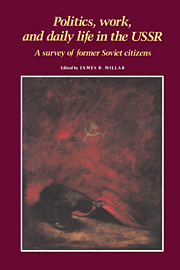Book contents
- Frontmatter
- Contents
- Foreword
- List of contributors
- PART I INTRODUCTION
- PART II POLITICS: SOURCES OF REGIME SUPPORT
- PART III WORK: ECONOMIC/DEMOGRAPHIC TRENDS
- 6 Inequality of earnings, household income, and wealth in the Soviet Union in the 1970s
- 7 The life course of Soviet women born 1905–1960
- 8 Productivity, slack, and time theft in the Soviet economy
- PART IV LIFE: SOCIAL STATUS, ETHNIC RELATIONS, AND MOBILIZED PARTICIPATION
- Appendix A The SIP General Survey sample
- Appendix B Response effects in SIP's General Survey of Soviet emigrants
- Glossary
- General bibliography of Soviet Interview Project publications
- Index
7 - The life course of Soviet women born 1905–1960
Published online by Cambridge University Press: 21 March 2010
- Frontmatter
- Contents
- Foreword
- List of contributors
- PART I INTRODUCTION
- PART II POLITICS: SOURCES OF REGIME SUPPORT
- PART III WORK: ECONOMIC/DEMOGRAPHIC TRENDS
- 6 Inequality of earnings, household income, and wealth in the Soviet Union in the 1970s
- 7 The life course of Soviet women born 1905–1960
- 8 Productivity, slack, and time theft in the Soviet economy
- PART IV LIFE: SOCIAL STATUS, ETHNIC RELATIONS, AND MOBILIZED PARTICIPATION
- Appendix A The SIP General Survey sample
- Appendix B Response effects in SIP's General Survey of Soviet emigrants
- Glossary
- General bibliography of Soviet Interview Project publications
- Index
Summary
The Soviet European urban population has low fertility, high female labor-force participation, and a high level of educational attainment. Low fertility in the urban part of the Soviet Union in combination with large Soviet losses in World War II led the Soviet government to encourage all able-bodied citizens to work for pay. The shortage of adult males after World War II helps to explain why the Soviet Union has the highest female laborforce participation rate of any country in the world. Partly to increase the productivity of labor, the building of a high-quality educational system has been a priority, and educational attainment has increased rapidly since the 1917 Revolution for both sexes.
The women interviewed in the Soviet Interview Project (SIP) General Survey are characterized by low fertility, high educational attainment, and high rates of labor-force participation to an even greater extent than Soviet urban women as a whole. The bulk of the SIP respondents are from very large cities. Most are Jews, and Jews have the highest average educational level of any nationality in the Soviet Union.
The lives of these well-educated Soviet urban women are relevant both to Soviet manpower policy and to understanding the implications of recent changes in female labor-force participation and fertility in the West. Figure 7.1 shows female labor-force participation rates by age in the United States for 1950 through 1983. Labor-force participation rates of women over 40 rose throughout the postwar era, as more and more women returned to the labor force as their children grew older.
- Type
- Chapter
- Information
- Politics, Work, and Daily Life in the USSRA Survey of Former Soviet Citizens, pp. 203 - 240Publisher: Cambridge University PressPrint publication year: 1987
- 3
- Cited by



